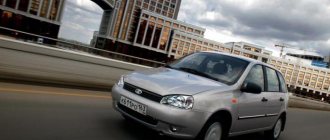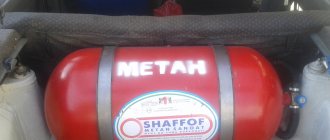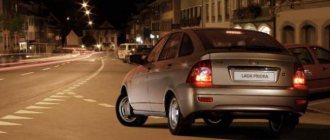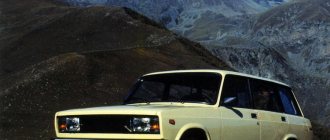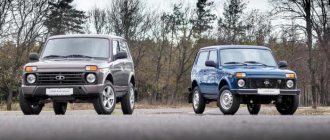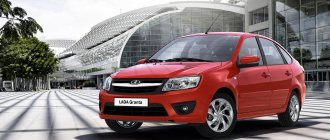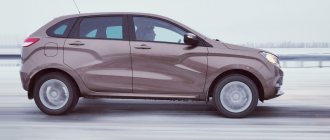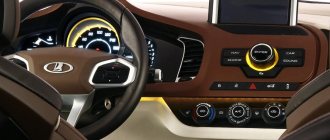It’s curious, but in more than 36 years of production, the notorious Niva has hardly changed, which, however, does not prevent it from being in stable demand, and not only in Russia. But if in our country it is the most affordable SUV on the market, then “over the hill” its cost is much higher. Let's say, in the same UK, the price tag for a LADA 4x4 starts at 13,000 British pounds, and this, excuse me, is almost five times more expensive than ours. At the same time, orders for the model do not subside. What can I say - the “dinosaur” is happily bought in more than a hundred countries around the world!
Although, in general, there is nothing to be surprised here - an ideal car for off-roading and practically indestructible. The main thing is that the future generation of SUVs does not degenerate into an ordinary city crossover, which is already disgusting, but retains all the advantages of its predecessor. True, we will have to wait at least three years for the new generation to be released, and it is possible that before the car goes on the assembly line, AVTOVAZ will change plans related to its modifications and modernization more than once. But everything has its time, but for now we suggest recalling the most successful modifications of the legendary “rogue” ever released.
VAZ 21218 “Fora”
Compared to the regular VAZ 2121, the Fora could boast of extended wheel arches, modified wheels, and also replaced the hard rear seats with a wide and comfortable sofa, borrowed from the V8. In addition, the car, produced at the PSA Bronto plant between 1996 and 2011, acquired doors enlarged by 300 mm and a roof raised by a plastic superstructure. As additional equipment, it was possible to order power steering, a protective “off-road” body kit, and even air conditioning.
VAZ 2131
An extended version of the model, which received five doors due to a half-meter insert into the standard body, due to which the distance between the first and second rows of seats increased by 125 mm. Of course, the wheelbase also increased in size, becoming 500 mm longer. Taking this into account, and not least because of the additional weight, the car began to accelerate noticeably worse and consume significantly more fuel. However, this did not stop post-Soviet buyers from lining up for it. However, you can buy such a car today. Moreover, now it has five-fold anti-corrosion protection for the paintwork, and CV joints have finally replaced the battered crosspieces in the driveline drive.
VAZ 212183 "Landole"
Until recently, this modification could also be purchased through pre-orders on the same PSA Bronto. The SUV, devoid of the upper part of the body, instead of which a power safety cage is installed, has become a kind of response to the American Jeep Wrangler. The usual trunk was replaced with an open side, and instead of doors, small plastic stops were installed to protect the interior from water and dirt. If necessary, the top was covered with a water-repellent tarpaulin, which, according to rumors, drained water no better than a colander in heavy driving rain. The picture was crowned by massive kangaroo pipes hanging around the entire perimeter of the car.
VAZ 2329 “Pickup”
A four-seater pickup truck with a wheelbase of 2700 mm, built on the basis of the five-door version of the Niva, received a rear overhang increased by 300 mm, as well as an additional fuel tank. Thus, the “all-terrain vehicle” with a carrying capacity of up to 650 kilograms began to contain as much as 84 liters of “fuel”. True, this had practically no effect on the power reserve. Another modification was produced in small quantities in a pickup truck body, only with a two-seater cabin - the VAZ 2328 “Wolf”. But unlike its “brother,” it did not gain popularity and was soon discontinued.
VAZ 21213 "Taiga"
The restyled variation of the VAZ 2121 in 1993 underwent changes, expressed in the new design of the rear lights and the long overhang of the trunk lid. In addition, the model gained contactless ignition, a Solex carburetor and, most importantly, a more powerful engine with a displacement of 1.7 liters. As for the interior, the cabin now features an updated instrument panel, fresher trim and softer seats. In this design, the car was to the taste of consumers and turned out to be no less popular than its predecessor.
Features of Niva Fora Bronto
The car is the brainchild of AvtoVAZ's subsidiary for the production of special vehicles - Bronto. The Niva Fora Bronto was first presented to the general public in 1998. Initially, this model was made specifically for cash collection in an armored version. The model with the VAZ 21218 index was called Force and was a mandatory vehicle in every banking institution.
The main difference from the traditional Niva is that the Fora has a 300 mm longer wheelbase. The body was cut in half and an additional piece of the specified size was inserted between the halves.
The result of the designers' work was, although not the most outstanding, but a harmonious design that stood out from the general background. As for the technical characteristics: the extension was done correctly, the joints are not located on one cross section, but are distributed along the entire length of the body. Strength parameters such as bending and torsion are completely preserved. The elongated door is one whole stamping - no separate elements connected to each other.
Salon
You won't be able to find anything new in the interior of the VAZ-21218. Here is the interior of a regular Niva.
The same inconvenient gear selector, the same VAZ steering wheel, hard plastic and velor upholstery. In general, nothing has been done to the ergonomics; it is still “lame,” as noted by the owners’ reviews. But talking about ergonomics is not entirely correct - the car was designed 40 years ago. Even tuning won't help here. You can equip your car with air conditioning, but this will not completely solve the issue of comfort inside.
Advantages and disadvantages of the car
This modification of the Niva, called Fora Bronto, can give a head start to the base model, primarily in terms of comfort. The front seats remain the same, but the rear seats have moved 150 mm back. The remaining 150 mm goes to the luggage compartment, which in the standard version does not have a large volume. The rear wheel arches are also moved back and are now located behind the rear passengers and do not interfere with them.
Instead of a small double seat, there is a full-fledged sofa that can comfortably accommodate three people. The seats were completely borrowed from the VAZ 2108. The rear row passengers are no longer cramped, they can stretch their legs. The roof was raised, which allowed for more headroom.
When the body was lengthened, a large hatch was cut out in the rear part of the roof, which was subsequently covered with a plastic overlay of greater height. Seats for rear passengers have increased 3 times in height, length and width. The dimensions of the car cannot be compared to a full-fledged sedan, but it has become more comfortable to sit in the back. Cars with an extended wheelbase have a smoother ride. Niva Fora confirms this by her own example.
The stability indicators of the modernized model have increased due to an increase in the distance between the front and rear axles. This is an important factor in the issue of passive safety. But a long wheelbase implies an increase in the cornering radius and a decrease in off-road qualities.
Lada 4×4 model range with photos and descriptions
Lada 4×4 is a Soviet and Russian cross-country passenger car. This SUV with a monocoque body and permanent all-wheel drive has gained popularity not only here, but also abroad. The car stands out for its low cost, high cross-country ability and ease of maintenance.
It is very difficult to show all modifications of the Lada 4×4 in the photo, because... the list is very wide, and some of the modifications did not receive further development at all. Next you can see all the popular Lada 4×4 models in the photo:
- VAZ 21212. Export Lada 4×4, the main feature of which is right-hand drive.
- VAZ 2122.600 “River”. Lada 4x4 with a body sealed at the bottom. For unknown reasons, the car did not make it onto the production line.
- VAZ 21215. Lada 4×4 with a diesel engine from Peugeot model XUD 9SD. The car was produced from 1999 to 2008.
- VAZ 2121F. The distinctive features of this Lada 4×4 are that there were two seats in front and an all-metal van in the back.
- VAZ 21218 Fora. Version of VAZ-21213 extended by 300 mm. Produced in small batches from 1996 to 2005. It differs from the base model in having larger doors and doorways, a raised rear roof due to a plastic superstructure, and a wider rear three-seater seat type 2108. The wheels are of increased diameter, so the spare tire is moved out of the engine compartment and secured above the rear bumper.
- VAZ 212182 Force. Lada 4×4 for cash collectors. During the modifications, the weight of the body was increased by 430 kg, so the suspension had to be strengthened. The car also had an automatic fire extinguishing system, as well as a protected fuel tank.
- VAZ 212183 Landole. A special feature of the model is the presence of a power safety cage. There are no doors, and the tailgate folds down. The interior is made of leatherette, and the floor is linoleum, which made it possible to wash the interior with a garden hose.
- VAZ 2131. Modification of the VAZ-21213, distinguished by its lengthening by 500 mm. wheelbase and a 5-door body with an additional pair of rear side doors.
- VAZ 2329. A four-seater pickup truck based on the VAZ 2129 has a diameter of 2700 mm. in wheelbase and has a load capacity of 650 kg. It has an original rear sofa that folds into the floor. Has an additional fuel tank.
- VAZ-21213 Taiga. The peculiarity of this Lada 4×4 is the long trunk lid. Also installed are new taillights, a Solex carburetor and contactless ignition. Engine 1.7 liters.
- VAZ 2328 Wolf. A two-seater pickup truck based on the popular VAZ 2121 SUV. Years of production: 1995 – 1997.
- Lada 4×4 “Tsarina” '2012. This car was a limited edition for the French market in honor of the 35th anniversary of the model.
- Lada 4×4 Niva “St-Tropez”. The first generation of Lada Niva Saint-Tropez was produced from 1984 to 1987 and received a body kit of a very unique design by Patrick Giraud. The second generation had a different body kit.
- VAZ-2121 Auviga. In the early 90s of the twentieth century, the Lithuanian company Auviga manufactured an unusual camping vehicle based on Lada 4×4. The highlight of the design was its modularity - the residential superstructure had its own axis and the entire structure was rigidly bolted to the base chassis, easily detachable from it if necessary. The disconnected residential module rested in front on special supports that gave it stability.
Sources
- https://art4online.ru/avto-testy/niva-udlinennaya-3-h-dvernaya.html
- https://automotocity.com/avtovaz/vaz-2121-fora-v-chem-otlichie.html
- https://7road.ru/novosti-avtovaza/niva-fora-bronto.html
[collapse]
Design features of Fora
The total curb weight of the vehicle has increased by 75 kg compared to the standard version of the Niva. According to the experts who developed the model, a slight increase in weight made it possible to use the existing chassis design without the need to change the entire suspension. Only the springs and shock absorbers were replaced. The braking system remains unchanged: disc brakes at the front, conventional drums at the rear. The model is equipped with power steering.
Under the hood, a 1.7-liter power unit, standard for all modifications of the Niva, is installed. Nothing significant was added to the design of the engine, although it is frankly weak for an SUV. The transmission is a five-speed gearbox with permanent all-wheel drive. There is a center differential lock and a two-speed transfer case. The driveshaft has become longer. The handicap is equipped with oversized tires on cast aluminum wheels. Because of this, the spare wheel migrated from under the hood to a bracket mounted on the rear door. This move only improved the design of the car.
Another stylish addition is the bumper grille, which the owner can order as an additional option if desired. According to the manufacturer, today this grille is the only certified one. The Fora can be additionally equipped with an air conditioning or fire extinguishing system.
“Handicap” – what is it?
“Niva Fora” is a three-door off-road vehicle with permanent all-wheel drive. The salon is made in the “Lux” configuration. The car can be used in any conditions. To achieve this, the designers equipped the model with everything possible. This is permanent all-wheel drive on all four wheels, differential locks, and high ground clearance. This model was first introduced in 1998. But all this is not the most important thing.
But the company did not stop there and, after successfully developing a machine for banks, began expanding the range. An all-terrain vehicle called “Marsh” and the “Niva Fora”, extended by 300 mm, were released. Together with “Marsh” and “Force”, “Fora” was shown at the Moscow Motor Show in 1997. The model was then of great interest to fans of SUVs. After this, Bronto receives a certificate for the sale of Fora.
Technical parameters of VAZ 212180
The base model of the VAZ 21213 was taken as a basis; there are three doors in the car, the wheel formula is 4x4. The Fora is 4.4 m long, 1.68 m wide, 1.75 m high, the distance between the wheel axles is 2.5 m, and the ground clearance is 319 mm. Roof load – no more than 50 kg.
- trunk volume – 256 liters;
- tire size – R16 205/75 and 175/80;
- engine - volume 1.7 liters, power 80 liters. s., torque – 128 Nm, acceleration from zero to “hundreds” in 20 seconds. Maximum speed – 140 km/h;
- transmission – 5-speed manual;
- vehicle weight – 2270 kg, maximum load – 450 kg;
- fuel tank volume – 42 l.
Advertisements for the request “Niva 21218” in Russia
Since this is an elongated car, its main difference from the standard Niva is in the body dimensions. The length of the “Fora” is 4040 mm, the width is 1680 mm, and the height of the car is 1750 mm. The wheelbase of the Fora is 2500 mm. Curb weight – 1270 kg. Maximum weight – 1720 kg. As you can see, the technical characteristics of the VAZ-21218 car remained unchanged. But they love this car not for its speed, but for its maneuverability.
Despite the fact that the Fora is almost no different in appearance from the standard model, the difference is immediately felt inside. Now you don't have to bend over to get to the back seat. And the front seating position is quite comfortable. Thanks to 300 mm, passengers have become much more comfortable. Now you no longer need to bend your knees. The seats were removed from the area of the wheel arches, due to which the already small width of the base became even more limited.
BRONTO-1922 “Marsh-1” is a snow and swamp-going vehicle (“pneumatic”) on ultra-low pressure wheels on VAZ-21213 units. It has been produced in small batches by JSC SPA BRONTO since 1997. Lada 4x4 21214-0000070-20 “Niva Lynx”
Changes in external and internal design
Visually, the Niva Fora differs from the basic version in several characteristic details. The first is the long front door. The second is the roof, which has become larger and higher due to the plastic lining on top. The appearance began to resemble the legendary Land Rover Defender, only in the upper part of the roof there are no additional small windows. The third difference is the spare wheel, which, due to its large size, does not fit under the hood and is installed on the rear door - so the Fora has become even more like a jeep.
On the first models, the wheel hung on a low-quality bracket, which caused a lot of inconvenience to the owners. To open the trunk, you first had to lift the spare tire and then move it to the side. If the weather was rainy, or there had been an off-road trip before, such manipulations always ended with soiled clothes. The designers took this drawback into account and equipped the bracket with a lever, by pulling which you can easily tilt the wheel to the side.
Welds and joints are practically invisible to the naked eye, and the strength of the body remains the same. The doors have additional handles with which rear row passengers can open the door.
In the cabin, the upholstery of the door panels and seats is made of ordinary materials; the former still lack additional pockets for small items. The salon is no different from the base model - the interior is completely consistent with the regular version of the Niva. The gearshift knob is just as uncomfortable, the steering wheel is VAZ. Ergonomics remained at a low level - modernization did not change anything significantly. You can try to add an air conditioning system, but this will not achieve a feeling of comfort.
Many car owners have a reasonable question: “Is it worth buying a Niva Fora?” This modification costs almost twice as much as the regular version of the car. The changes that the SUV has undergone are clearly not worth the money they are asking for. The Niva with five doors is also cheaper than the Fora. There is no point in overpaying for the long body and characteristics of the standard version of the car.
One of the most interesting and respected creations of the domestic automobile industry is the Niva car. This Soviet and then Russian SUV was highly popular and was even exported to other countries of the world. Based on it, a considerable number of modifications were created, many of which are little-known, but very interesting.
The first Niva rolled off the assembly line in 1977 and immediately won the hearts of motorists. Under the hood was an in-line engine with a capacity of 80 horsepower per 1.6 liter. It was equipped with a four-speed gearbox. Slightly different models were sent for import - with a 1.3-liter engine.
Kia Niro 2022 - model review, photos
Advertisements with photos for the sale of Lada 21218 Fora: find out how much it costs and who is best to buy Lada 21218 Fora. Used cars with service history from the owner.
The door is welded in two parts. The outer part of the structure is a monolithic steel sheet. The long doors in the Bronto even had additional opening handles for passengers in the back row. The glass is large enough - the size of the door. The inside of the part is finished with standard materials. What some owners don’t like is the lack of pockets for small items inside the door cards.
Deutsche Lada Niva Cabrio
German masters were interested in changing the Soviet Niva. So in 1983, based on this SUV, Deutsche Lada Automobil GmbH, which was the official importer of these cars, introduced a convertible, which completely lacked side pillars and roof strength elements. But a tubular frame appeared, with which they decided to strengthen the body.
The new version has front seats with head restraints, enhanced lateral seat support and seat belts. Additionally, plastic fender extensions were used, which were painted in the color of the car and gave it a more impressive look.
Test Drive
On the track the car handles quite confidently. There are no more jumps like the short Niva. The suspension absorbs road bumps well. It seems that this is not a tough and serious SUV, but a comfortable passenger car. The car also performed better in corners than the standard Niva. However, a larger turning radius was noticeable - after all, the long wheelbase makes itself felt.
But asphalt is not the place for the VAZ-21218. The test drive should be carried out on muddy dirt roads, in sand. And the car copes here no worse than the basic version. All the advantages and characteristics declared by the manufacturer have been fully confirmed.
Bronto-1922-55 "Marsh-Combi"
This is a newly modified Niva car, which was transformed by specialists from Bronto. The basis of the transport was the bridges and frame of the UAZ-3151, but the body was used from the VAZ-21213. The first thing that catches your eye is the huge pneumatic wheels, which allow this vehicle to move on low-traffic soils, which is where the name “March” comes from, meaning “swamp” in French. The gearbox, engine and transfer case still remain from the Niva in this seriously updated SUV.
Station wagon
The VAZ-2131 is the leader in this category. It’s especially good for rear seat passengers - even three can fit comfortably, and “personal” seats make it much easier for them to get in and out. Folding the seat creates an impressive cargo area. Unfortunately, the permissible total weight of a towed trailer is the same as that of the “small” VAZ-21214: 300 kg without brakes, 600 kg with brakes.
Second place is deservedly taken by the Chevrolet Niva - five convenient doors, the ability to fold the rear seat in parts, permission from the manufacturer to tow a trailer equipped with brakes with a total weight of up to 1200 kilograms! The last circumstance is very important for all-wheel drive vehicles, because they are often purchased for transporting snowmobiles and jet skis. The Fora is inferior to the Chevy in having fewer doors and only a fully foldable rear seat.
The Fora is inferior to the Chevy in having fewer doors and only a fully folding rear seat.
VAZ-21214 is in last place here. The reason is a very cramped rear seat and a tiny trunk. Perhaps, it is possible to transport anything significant in the “short” Niva only in a two-seater version.
Mikhail Ledyaev, leading test engineer at the Bureau of Development of Off-Road Vehicles (NTC AvtoVAZ):
